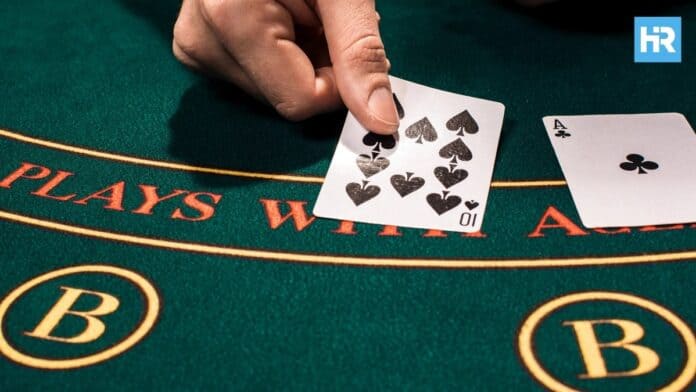Blackjack remains one of the most studied table games in the casino industry, and no wager sparks as much debate as the insurance bet.
Marketed as a protective side option when the dealer shows an Ace, it promises a payout of 2:1 if the dealer’s hole card completes a blackjack. While it may appear to safeguard a strong hand, the numbers behind this bet tell a different story.
Understanding how insurance functions is essential for anyone looking to approach the game with a clear view of risk and reward. The mechanics, odds and expected value calculations reveal why most experts agree it is rarely advisable.
Beyond the arithmetic, variations in casino rules and common misconceptions influence how this option plays out on the felt.
By taking a closer look at these elements, players can learn why the insurance bet is typically avoided and when highly skilled counters are the rare exceptions.
How Does Insurance Work in Blackjack: The Mechanics of the Bet
The insurance wager is one of the most misunderstood features of the game. To understand why it is often avoided, it is helpful to examine how it is placed, what it pays and how rule variations impact the outcome.
While the concept may seem straightforward, the details reveal why its expected value is generally negative for most players.
Placing and Paying the Insurance Bet
When the dealer shows an Ace, players are given the option to place an insurance bet. This side wager can be made for up to half of the original stake.
If the dealer’s facedown card is a 10-value, the insurance bet pays out at 2:1, effectively offsetting the loss of the main wager. However, if the dealer does not have blackjack, the insurance bet loses, and play continues as usual.
This is also where the term even money blackjack comes into play.
If a player has a natural 21 and the dealer shows an Ace, casinos often offer ‘even money.’ This is mathematically identical to taking insurance, as the player is essentially locking in a guaranteed 1:1 payout rather than risking a push.
From a purely mathematical standpoint, both choices yield the same expected value, which is typically unfavorable in the long run.
Rule Variations That Influence Insurance (Peek vs No Peek Blackjack)
The way insurance plays out can shift slightly depending on house rules. In American-style games with a peek rule, the dealer checks the hole card before further action. This protects players from losing additional wagers on splits or doubles if the dealer has blackjack.
In contrast, European no hole card insurance means the dealer does not check until the round is complete, which increases the risk of players losing more money on extra bets before learning the dealer’s outcome.
Other variations also affect the procedure; multi-deck games usually make the insurance bet less favorable than single-deck games because of the higher ratio of non-ten-value cards to tens.
Differences between H17 (dealer hits on soft 17) and S17 (dealer stands on soft 17) rules do not change the payout of insurance directly, but can slightly affect overall game odds. These small shifts highlight why rule knowledge is essential when analyzing insurance options and how they fit into blackjack side bets overall.
Blackjack Insurance Odds and Expected Value
The decision to take insurance ultimately comes down to math. The odds of the dealer having a ten-value card in the hole rarely align with the payout structure, which means the bet is unfavorable under standard conditions.
By analyzing probabilities and expected value, the weaknesses of this side wager become clear.
Comparing True Odds to the Payout
When the dealer shows an Ace, the insurance bet pays 2:1 if the hole card is a ten-value card. However, the true odds of this happening are usually lower than one in three, depending on the number of decks in play.
In a standard six-deck game, there are 96 tens out of 312 unseen cards, meaning the probability is about 30.7 percent. Because the payout is based on a 33.3 percent threshold, players are making a wager that does not support the return mathematically.
This is why the insurance bet EV (expected value) is negative in the long run. The house edge is built into the gap between payout and probability, and no amount of superstition can close that gap. Even skilled players must acknowledge that this statistical mismatch is what keeps the casino profitable.
Infinite Decks, Finite Decks and Mental Math
Another complication is the difference between infinite-deck approximation and finite-deck composition. The infinite-deck model assumes that every new card has the same probability as the last, making the math easier but less realistic. In practice, as cards are dealt, the composition of the shoe changes, slightly altering the true odds.
Card counters use this finite-deck principle to track when the shoe is rich in ten-value cards, which can sometimes turn insurance into a profitable move. For casual players, relying on gut instinct is risky, and the numbers show why.
A practical shortcut is the so-called ‘one-third rule’: if more than a third of the remaining cards are tens, insurance becomes break-even or better. Without counting, though, those conditions are rarely met.
Strategy and Break-Even Math in Blackjack Insurance
While the numbers show that insurance is usually unfavorable, the strategy helps explain when players might still consider it. Basic strategy insurance charts consistently advise against the bet, except under particular conditions that typically involve card counting insurance.
Break-even points and mental shortcuts provide further clarity on why most players are better off skipping it.
Basic Strategy Versus Card Counting
Basic strategy insurance guidance is simple: never take the bet as a non-counter.
Since the true odds rarely support the 2:1 payout, players who are not tracking card distribution face a long-run negative return. This recommendation is universal across blackjack strategy guides and is one of the most repeated rules in the game.
Card counters, however, look at insurance differently. When the count shows that a shoe is heavily loaded with ten-value cards, the odds can tip in their favor.
At this point, insurance transforms from a losing bet into a potentially profitable one. That is why professional counters sometimes describe insurance as the most critical side bet, even though it remains a poor choice for the average player.
Break-Even Points and Mental Shortcuts
The math behind break-even insurance is straightforward. To justify a 2:1 payout, the dealer must have a ten-value in the hole at least 33.3 percent of the time. If the shoe composition suggests a lower likelihood, insurance is a negative-value wager.
This is where quick math, like the ‘one-third rule,’ becomes useful. If one out of every three remaining cards is worth ten, insurance is a break-even proposition, and anything above that makes the bet favorable.
Myths, Pitfalls and Player Psychology in Blackjack Insurance
Blackjack insurance explained through numbers is clear, yet many players still choose to place this wager.
Myths, psychological biases and table superstitions influence decision-making, often leading to losses. Understanding these factors is essential for avoiding common mistakes that erode bankrolls.
Misconceptions About Strong Hands
One of the most common misconceptions is that strong hands, such as a hard 20, should be insured when the dealer shows an Ace. The thinking is that protecting a good hand makes sense. In reality, the hand’s value is irrelevant because the insurance bet is based solely on whether the dealer has blackjack.
Betting extra on a statistical long shot only adds risk without changing the outcome.
Another pitfall involves even-money blackjack offers. While it may sound like a guaranteed win on a player’s natural, it is simply insurance in disguise. The player gives up the possibility of a 3:2 payout in exchange for an inevitable 1:1 return, which carries the same negative expectation as the insurance bet itself.
Superstitions and Emotional Traps
Superstitions at the table also encourage players to insure. Beliefs that the dealer is ‘due’ for a blackjack or that insuring maintains table harmony are examples of emotional traps. These ideas have no mathematical grounding, yet they create intense pressure in live casino environments.
Psychology plays a decisive role here, as players often seek control in uncertain situations, and side bets like insurance provide the illusion of safety. The outcome, however, is governed by probability, not feelings. Recognizing these traps helps players approach the game with clarity instead of emotion.
For bettors who want to compare broader gaming opportunities, resources that review the best offshore casinos highlight how different operators handle side bets, odds and player protections. These insights mirror the importance of separating fact from myth when evaluating blackjack side bets.
Responsible Play and Bankroll Management for Blackjack Insurance
The insurance bet highlights why side wagers can be dangerous to long-term bankroll health. Although the payout appears attractive, the volatility it introduces outweighs the benefits for most players.
Managing money responsibly is key to maintaining consistency at the blackjack table.
Variance and the Illusion of Protection
Side bets, such as insurance, increase variance without offering a positive expected value. Players may feel they are protecting their stake, but in reality, they are exposing themselves to bigger swings in results. Over time, this makes bankrolls more vulnerable to depletion.
The illusion of protection is compelling with dealer ace insurance, since it appears to shield a strong hand against the dealer’s possible blackjack. Yet, the data show that consistently making this bet leads to long-term losses.
Discipline and Tools for Safer Gambling
Setting limits on how much to wager per session, avoiding unnecessary side bets, and knowing when to walk away are the cornerstones of sustainable play. Tools like limit-setting links and helplines can provide structure for those who need external support.
Many online platforms also encourage safer play through self-exclusion or deposit limits. Exploring platforms that prioritize transparency, such as those listed among no-KYC casinos, can help players identify operators that offer flexible control tools. This reinforces the importance of approaching gambling with long-term sustainability rather than short-term emotion.
Applying the Basic Strategy Insurance
Blackjack insurance explained through mechanics, odds and strategy makes clear why it is considered one of the weakest wagers in the game. Outside of rare card counting insurance scenarios, the numbers confirm that it is almost always a losing proposition.
The long-term takeaway is that sticking to basic strategy insurance rules protects bankrolls and minimizes unnecessary variance. By understanding how insurance works in blackjack and why it rarely adds value, players can approach the game with sharper insight.






